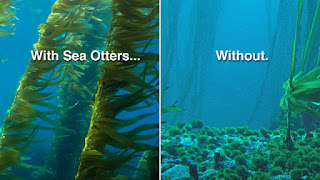Keystone Species: What They Are and Why You Should Care
Keystone Species: What They Are and Why You Should Care
A keystone species is any organism that is irreplaceable in its ecosystem. These animals, plants, fungi, and other life forms significantly influence their surroundings and the number of other members of their food webs. A defining feature of keystone species is that though they have a large impact, they’re not incredibly abundant. Sea otters, African elephants, fig trees and hummingbirds are all examples of keystone species.
Keystone species are often predators, not prey species. Their job is to keep other species in check and maintain balance in the ecosystem. Sea otters prey on sea urchins in kelp forests. Without this interaction, the kelp forests would be completely diminished by the sea urchins. African elephants, on the other hand, create more grazing land in the savannahs, which increases the quantity and type of grazing animals that can live there, including gazelles, etc. . African elephants help to promote biodiversity in their environment, rather than keeping other populations in check.
Fig trees and hummingbirds represent more subtle types of keystone species. Fig trees, while certainly not predators, help to maintain their ecosystems by providing resources in the form of food, housing and building materials for other birds as well as mammals. Without the constant supply of resources, these dependent species would struggle to sustain their populations. Hummingbirds, like bees, are pollinators that we and other species heavily rely on. Hummingbirds work as a link to maintain plant populations that help support other populations of animals.
In the New England region, copepods are a major primary producer and source of energy for fish, birds and marine mammals. Basking sharks and North Atlantic right whales consume copepods as filter feeders. Small fish eat copepods and are consumed by larger fish or by birds. Crabs and shrimp also feed on these tiny organisms.
Keystone species, despite their importance to the environment and their own ecosystems, are not immune to the threats that the rest of the natural world faces. Climate change and human action is especially detrimental when it encroaches on the lives of these species because they uphold many other species. This makes conservation efforts and general respect for plants and animals imperative, as the collapse of one species means the collapse of many.
For more information and further reading, use the following websites:
https://www.nationalgeographic.org/encyclopedia/keystone-species/
https://web.utk.edu/~mnunez/Keystones%20Nunez%20Dimarco.pdf
https://www.britannica.com/science/keystone-species
https://www.nature.com/scitable/knowledge/library/keystone-species-15786127
https://www.st.nmfs.noaa.gov/copepod/about/what-n-why.html
By NECWA Intern Lydia Myers
A keystone species is any organism that is irreplaceable in its ecosystem. These animals, plants, fungi, and other life forms significantly influence their surroundings and the number of other members of their food webs. A defining feature of keystone species is that though they have a large impact, they’re not incredibly abundant. Sea otters, African elephants, fig trees and hummingbirds are all examples of keystone species.
 |
| A kelp forest with otters, and without https://seaotters.com/2013/05/why-are-sea-otters-important-no-sea-otters-no-kelp-forests/ |
Keystone species are often predators, not prey species. Their job is to keep other species in check and maintain balance in the ecosystem. Sea otters prey on sea urchins in kelp forests. Without this interaction, the kelp forests would be completely diminished by the sea urchins. African elephants, on the other hand, create more grazing land in the savannahs, which increases the quantity and type of grazing animals that can live there, including gazelles, etc. . African elephants help to promote biodiversity in their environment, rather than keeping other populations in check.
 |
| African Elephants in the savannah https://www.nationalgeographic.org/encyclopedia/keystone-species/ |
Fig trees and hummingbirds represent more subtle types of keystone species. Fig trees, while certainly not predators, help to maintain their ecosystems by providing resources in the form of food, housing and building materials for other birds as well as mammals. Without the constant supply of resources, these dependent species would struggle to sustain their populations. Hummingbirds, like bees, are pollinators that we and other species heavily rely on. Hummingbirds work as a link to maintain plant populations that help support other populations of animals.
In the New England region, copepods are a major primary producer and source of energy for fish, birds and marine mammals. Basking sharks and North Atlantic right whales consume copepods as filter feeders. Small fish eat copepods and are consumed by larger fish or by birds. Crabs and shrimp also feed on these tiny organisms.
 |
| Copepods https://www.st.nmfs.noaa.gov/copepod/about/what-n-why.html |
Keystone species, despite their importance to the environment and their own ecosystems, are not immune to the threats that the rest of the natural world faces. Climate change and human action is especially detrimental when it encroaches on the lives of these species because they uphold many other species. This makes conservation efforts and general respect for plants and animals imperative, as the collapse of one species means the collapse of many.
For more information and further reading, use the following websites:
https://www.nationalgeographic.org/encyclopedia/keystone-species/
https://web.utk.edu/~mnunez/Keystones%20Nunez%20Dimarco.pdf
https://www.britannica.com/science/keystone-species
https://www.nature.com/scitable/knowledge/library/keystone-species-15786127
https://www.st.nmfs.noaa.gov/copepod/about/what-n-why.html



Comments
Post a Comment